

Babel No More: The Search for the World's Most Extraordinary Language Learners (9781451628258): Michael Erard. Memory Is Not a Recording Device: How Technology Shaped Our Metaphors for Remembering. By Maria Popova Debunking the myth that memory is about “reliving” a permanent record stored in a filing cabinet.

Why We Seek the New: A History and Future of Neophilia. By Maria Popova What five-year-old Albert Einstein can teach us about serendipity and the filter bubble of information.
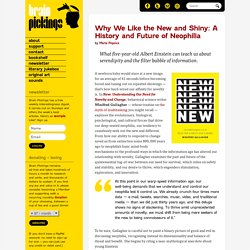
A newborn baby would stare at a new image for an average of 41 seconds before becoming bored and tuning out on repeated showings — that’s how hard-wired our affinity for novelty is. In New: Understanding Our Need for Novelty and Change, behavioral science writer Winifred Gallagher — whose treatise on the myth of multitasking you might recall — explores the evolutionary, biological, psychological, and cultural forces that drive our deep-seated neophilia, our tendency to ceaselessly seek out the new and different. At this point in our warp-speed information age, our well-being demands that we understand and control our neophilia lest it control us. Brain Preservation Now! Brain Preservation Foundation. Mind reading is possible! “If you have something that you don’t want anyone to know, maybe you shouldn’t be doing it in the first place.” Eric Schmidt, CEO of Google Three motives drive neuroscience research: the clinician’s urge to heal, the analyst’s urge to understand, and the engineer’s urge to improve.
Understanding and repairing the brain have always gone along with wanting to improve it, and proponents of human enhancement have eagerly anticipated the brain supremacy. Could brain techniques like neuroimaging be used to extend or transcend natural human capacities, for instance by allowing us more direct access to other minds? Are neuroscientists the next great architects? Touring the brain.
Evolution has created a staggering range of organisms, each with features cleverly honed for its environmental niche.
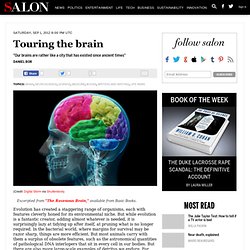
But while evolution is a fantastic creator, adding almost whatever is needed, it is surprisingly lazy at tidying up after itself, at pruning what is no longer required. In the bacterial world, where margins for survival may be razor sharp, things are more efficient. But most animals carry with them a surplus of obsolete features, such as the astronomical quantities of pathological DNA interlopers that sit in every cell in our bodies. But there are also more large-scale examples of detritus we endure. For instance, whenever we get cold, our hair duly stands on end to create a buffer of trapped air around our skins, as if such an action would make any difference to keep us cocooned from the cold—it doesn’t (unlike other primates, we simply don’t have enough hair to make this automatic response functional).
Home - Organization for Human Brain Mapping. Did a Copying Mistake Build Man's Brain? A copying error appears to be responsible for critical features of the human brain that distinguish us from our closest primate kin, new research finds.
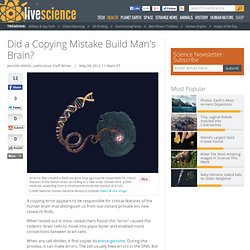
When tested out in mice, researchers found this "error" caused the rodents' brain cells to move into place faster and enabled more connections between brain cells. When any cell divides, it first copies its entire genome. During this process, it can make errors. The Self Illusion: How the Social Brain Creates Identity. How Physics and Neuroscience Dictate Your "Free" Will. In a remote corner of the universe, on a small blue planet gravitating around a humdrum sun in the outer districts of the Milky Way, organisms arose from the primordial mud and ooze in an epic struggle for survival that spanned aeons.

Despite all evidence to the contrary, these bipedal creatures thought of themselves as extraordinarily privileged, occupying a unique place in a cosmos of a trillion trillion stars. Conceited as they were, they believed that they, and only they, could escape the iron law of cause and effect that governs everything. They could do this by virtue of something they called free will, which allowed them to do things without any material reason. Can you truly act freely? The question of free will is no mere philosophical banter; it engages people in a way that few other metaphysical questions do. Let’s say you are living with a loving and lovely spouse. We’re wired to sing. Poor Alfred Russel Wallace!

Human brain. The human brain has the same general structure as the brains of other mammals, but has a more developed cortex than any other.
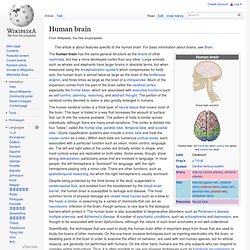
Large animals such as whales and elephants have larger brains in absolute terms, but when measured using the encephalization quotient which compensates for body size, the human brain is almost twice as large as the brain of the bottlenose dolphin, and three times as large as the brain of a chimpanzee. Much of the expansion comes from the part of the brain called the cerebral cortex, especially the frontal lobes, which are associated with executive functions such as self-control, planning, reasoning, and abstract thought.
The Brain: The Mystery of Consciousness. The young women had survived the car crash, after a fashion.
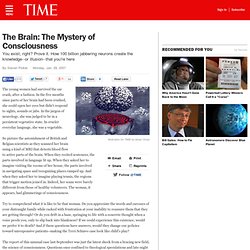
In the five months since parts of her brain had been crushed, she could open her eyes but didn't respond to sights, sounds or jabs. In the jargon of neurology, she was judged to be in a persistent vegetative state. In crueler everyday language, she was a vegetable. So picture the astonishment of British and Belgian scientists as they scanned her brain using a kind of MRI that detects blood flow to active parts of the brain.
When they recited sentences, the parts involved in language lit up. Is language the brains operating system? The Blogs at HowStuffWorks. So my wife and I were discussing Josh and Chuck’s recent podcast on our culture’s dire need for innovators, teleportation and a universal language.

We both agreed on the first count, but were split on the other two. Setting aside the ethical and possibly gene-splicing issues of teleportation, I just couldn’t get behind the idea of a universal language. Recently, I finally got around to reading Neal Stephenson’s cyberpunk classic “Snow Crash” and there’s a great deal of interesting stuff in the book about human language as an operating system and how the trend toward divergence in language actually prevents and protects us from widespread harm. Memetics. This article is related to the study of self-replicating units of culture, not to be confused with Mimesis.
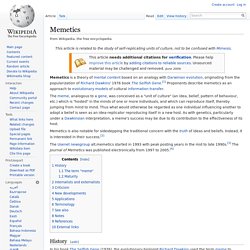
Memetics is a theory of mental content based on an analogy with Darwinian evolution, originating from the popularization of Richard Dawkins' 1976 book The Selfish Gene.[1] Proponents describe memetics as an approach to evolutionary models of cultural information transfer. The meme, analogous to a gene, was conceived as a "unit of culture" (an idea, belief, pattern of behaviour, etc.) which is "hosted" in the minds of one or more individuals, and which can reproduce itself, thereby jumping from mind to mind. Thus what would otherwise be regarded as one individual influencing another to adopt a belief is seen as an idea-replicator reproducing itself in a new host. Phobias: New Research on How to Fix Irrational Fears. Let's get this out of the way right up front: I'm afraid of people eating.
Some people are scared of snakes or flying or heights or other things that can actually be dangerous. I'm filled with overpowering, irrational dread by the sight or sound of another human being eating or drinking. It doesn't make any more sense to me than it does to you. 7 Mind-Bending Facts About Dreams. Jeanna Bryner, LiveScience Managing Editor | December 02, 2011 02:55pm ET Credit: Stockxpert You are getting sleepy, very sleepy.
When your head hits the pillow it’s lights out for the brain and body, right? Not if you consider the brain cells that must fire to produce the sometimes vivid and sometimes downright haunted dreams that take place during the rapid-eye-movement stage of your sleep. Why do some people have nightmares while others really spend their nights in bliss? Thinking in foreign language makes decisions more rational. In brief. Human Brain Project - Simulation. Open Connectome Project. Brain Scanner Being Used To Give Stephen Hawking A New Voice. Generating Text from Functional Brain Images. 1 Introduction Over the last decade, functional magnetic resonance imaging (fMRI) has become a primary tool for identifying the neural correlates of mental activity.
Traditionally, the aim of fMRI experiments has been to identify discrete, coherent neuroanatomic regions engaged during specific forms of information processing. More recently, it has become clear that important information can be extracted from fMRI by attending instead to broadly distributed patterns of activation. The application of machine learning techniques for pattern classification (Pereira et al., 2009) has enabled impressive feats of “brain reading,” making it possible to infer the semantic category of an object viewed by an experimental participant, to track the process of memory retrieval, to predict decisions or mistakes, or even (controversially) to detect lies (Mitchell et al., 2004; Davatzikos et al., 2005; Haynes and Rees, 2006; Norman et al., 2006). Scientists Use Brain Waves To Eavesdrop On What We Hear.
Table of Contents, Section 1: Neuroscience Online: An Electronic Textbook for the Neurosciences.